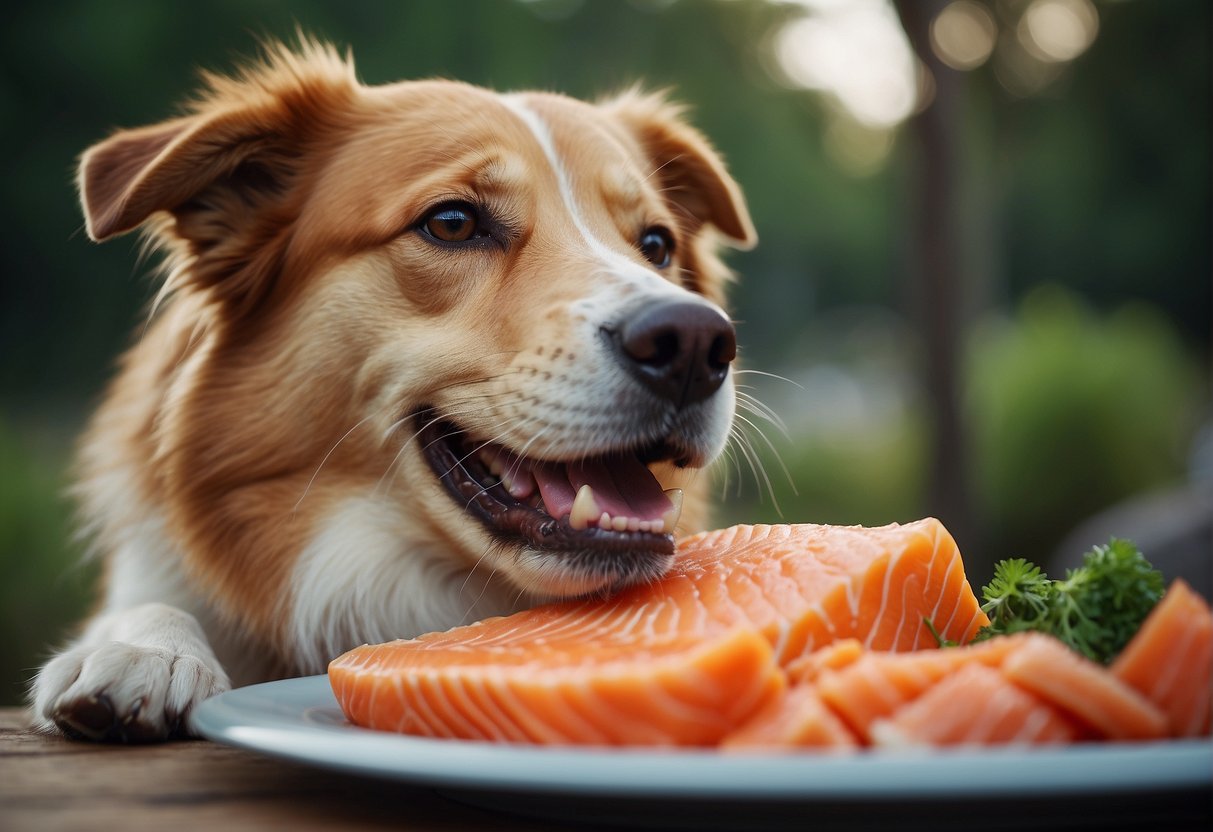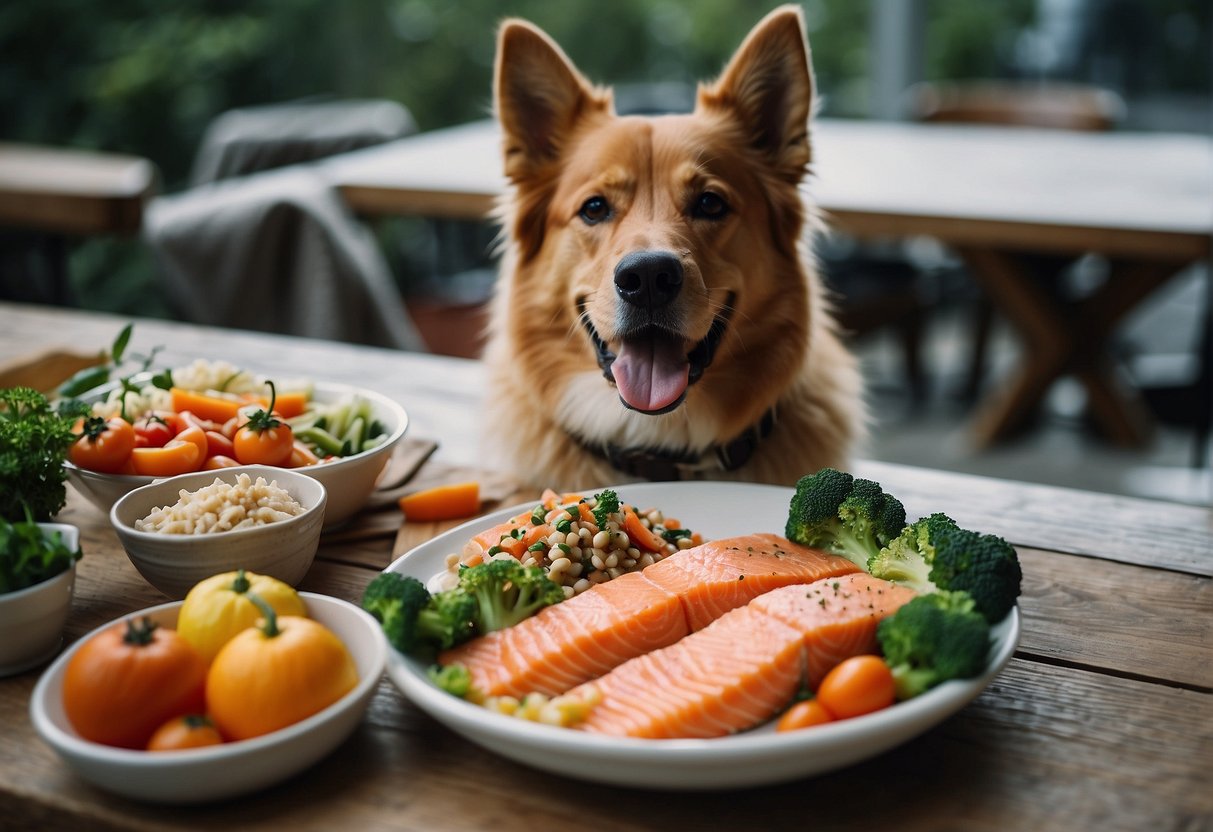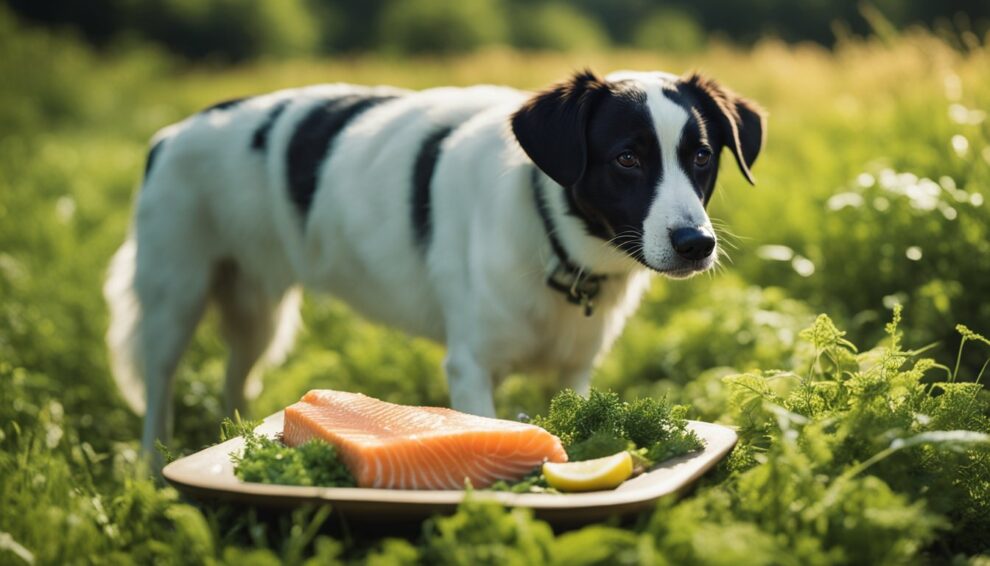Feeding dogs a well-rounded diet is essential for their health, and many pet owners consider including various types of fish, like salmon.
Salmon for dogs can be beneficial because it’s rich in omega-3 fatty acids, which are known to support the immune system, decrease inflammation, and contribute to a shiny and healthy coat.
Nutritionists often point out the value of these fatty acids for a dog’s overall wellness, particularly in promoting heart health and joint mobility.

However, introducing salmon into a dog’s diet is not without its considerations.
One must be aware that not all salmon is created equally.
Wild salmon, often regarded as a superior option due to lower contaminant levels compared to farmed varieties, may still pose risks.
The risk of parasites is a concern when it comes to raw or improperly cooked wild salmon, which can be detrimental to a dog’s health.
Thus, while considering salmon as a dietary addition for canines, it’s crucial to weigh the pros and cons.
Providing dogs with salmon should be done cautiously, ensuring it’s appropriately prepared to avoid any potential health hazards.
It’s also critical to take into account any individual dietary requirements or allergies that a dog may have to ensure that salmon is a suitable choice for their specific nutritional needs.
Nutritional Benefits of Salmon for Dogs

Salmon serves as an excellent addition to a dog’s diet, being packed with high-quality protein, essential omega fatty acids, and a variety of vitamins and minerals.
These components are key to maintaining a dog’s overall health and vitality.
High-Quality Protein Source
Salmon is rich in high-quality protein, which is essential for a dog’s muscle development and energy levels.
An adequate intake of protein is crucial for a dog’s growth, tissue repair, and immune function.
Protein from salmon is particularly beneficial for its ease of digestibility and the complete amino acid profile it provides.
Omega Fatty Acids for Skin and Coat Health
One of the primary benefits of salmon for dogs is its abundance of omega-3 fatty acids, which are known for supporting skin and coat health.
These fatty acids can help keep a dog’s skin moisturized and their coat shiny.
Regular consumption of omega-3s may also have anti-inflammatory effects, which can help manage skin allergies and conditions.
Vitamins and Minerals Boost
Salmon also offers a host of vitamins and minerals that contribute to a dog’s health:
- Vitamin D: Vital for bone health and growth.
- Potassium: Supports heart health, muscle function, and is essential for proper hydration and nerve function.
- Vitamin B12: Integral for nervous system health and critical metabolic processes.
These nutritional elements in salmon support overall wellness, from maintaining energy levels to ensuring a well-functioning immune system for dogs.
Risks and Precautions When Feeding Your Dog Salmon

Feeding your dog salmon can be beneficial, but it is crucial to be aware of the risks and necessary precautions to prevent health issues such as salmon poisoning and dietary complications.
Avoiding Salmon Poisoning Disease
Salmon poisoning disease is a serious condition caused by the neorickettsia helminthoeca parasite, which can be present in raw salmon.
Symptoms of this disease include vomiting, diarrhea, fever, and weight loss.
Consult a vet immediately if your dog exhibits these symptoms.
To prevent salmon poisoning, ensure the salmon is well-cooked to kill the harmful parasites and bacteria.
Beware of Bones and Choking Hazards
Bones in salmon pose a choking risk and can cause internal damage or blockages.
Always check the salmon for bones and remove them meticulously before feeding it to your dog.
Controlling Portion Sizes and Salt Content
Limit the portion size of salmon to avoid obesity and pancreatitis.
High amounts of salt content in some salmon preparations can also be harmful.
Moderation is key, and unsalted salmon is the best choice.
Salmon is a good omega-3 fatty acids source, beneficial for conditions such as allergies and cancer, but it should only be included in your dog’s diet occasionally to prevent mercury exposure.
Safe Ways to Prepare Salmon for Dogs

Feeding your dog salmon can be beneficial, but it’s crucial to prepare it correctly to prevent health risks.
Proper selection and cooking methods ensure the meal is safe for canine consumption.
Choosing the Right Salmon
When picking salmon for your furry friend, opt for boneless cuts to prevent choking hazards.
Canned salmon is a convenient option and should be packed in water rather than oil or brine, which can contain harmful additives.
High-quality dog foods often include salmon that’s already appropriately prepared for your pet.
If choosing fresh salmon, make sure it’s of high quality to reduce the risk of harmful bacteria which can cause infection.
Cooking to Safe Internal Temperatures
The aim is to cook salmon to a safe internal temperature of 145 degrees Fahrenheit to kill off any harmful bacteria or potential parasites, such as flukes.
One should fully cook the fish, avoiding any seasoning—especially ingredients like garlic or onion, which are toxic to dogs.
Undercooked salmon is a no-go as it can harbor dangerous pathogens.
Once properly cooked, let the salmon cool down before offering it to your pet to further ensure its safety.
Incorporating Salmon into Your Dog’s Diet

Introducing salmon to your pet’s meals can offer notable health benefits, but it’s essential to do so with care to maintain nutritional balance and safety.
Frequency and Portion Control
When they include salmon in their dog’s diet, pet owners should do so on an occasional basis and in controlled portions.
Salmon is high in protein and other nutrients, but excessive amounts can disrupt the dietary balance and potentially lead to weight gain.
An ideal serving size depends on the dog’s size and dietary needs, but a general guideline is to limit salmon to one or two servings per week.
Salmon as Part of a Balanced Diet
Salmon can be an excellent protein source for dogs and is known for benefits such as supporting coat health and reducing inflammation.
Incorporating salmon as part of a balanced diet means pairing it with other dog food sources to ensure a comprehensive nutrient intake.
Including the right balance of salmon dog food, rich in omega-3 fatty acids, may support the immune system and help in conditions like arthritis.
Always remember, whether the salmon is farmed or wild, it must be properly cooked and deboned to prevent the dog from getting sick.
Salmon should never replace complete meals but rather complement the pet’s regular diet, enhancing it without exceeding the budget.
Alternatives to Feeding Raw or Fresh Salmon
When considering the safety and health of their dogs, pet owners often look for alternatives to raw or fresh salmon, which can carry risks.
Here are some safer options that can provide the nutritional benefits without the associated dangers.
Considering Canned, Cooked, and Commercial Options
Canned Salmon: Canned salmon is a convenient and generally safe choice for dogs as it is usually fully cooked during the canning process, which eliminates harmful bacteria.
Moreover, canned fish, canned oysters, and frozen mussels are typically cooked, making them safer options.
When selecting canned salmon for dogs, owners should opt for versions without added salts or flavorings that can be harmful to their pets.
Cooked Salmon: Cooking salmon adequately is crucial as it destroys parasites and bacteria that may be present in raw fish.
Pet owners can prepare cooked salmon as a special treat, ensuring it is thoroughly cooked and deboned.
However, as with all human foods, moderation is key to prevent issues such as pancreatitis, which can occur from feeding too much rich food.
Smoked Salmon: While smoked salmon might seem like a tasty option, it is not recommended for dogs due to its high salt content.
The curing process often involves ingredients like salt, sugar, and spices that are not suitable for canine diets.
Salmon Dog Food: There are many high-quality dog foods on the market that include salmon as a primary ingredient.
These foods offer a balanced diet that is formulated specifically for a dog’s nutritional needs.
Brands like Purina ONE SmartBlend include real salmon and tuna in their ingredients.
- High-Quality Dog Foods: When searching for a suitable dog food containing fish, owners should look for high-quality options that list fish among the first few ingredients.
The label should indicate the presence of omega-three fatty acids and antioxidants without fillers, facilitating easy digestion.
Owners interested in adding variety to their dog’s diet can consider other forms of fish such as tuna or shrimp, always cooked and in moderation to avoid mercury exposure and maintain a balanced diet.
Each alternative has its pros and cons, but all can contribute to a nutritious and balanced diet for canines when chosen wisely and fed in appropriate amounts.















